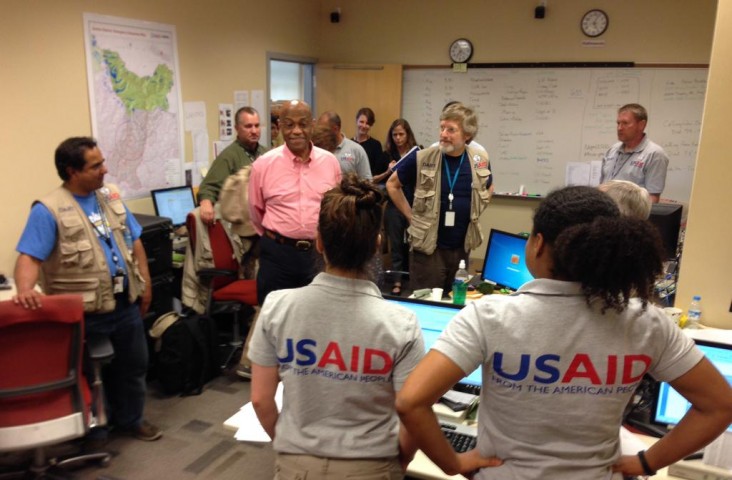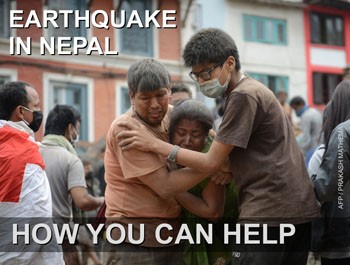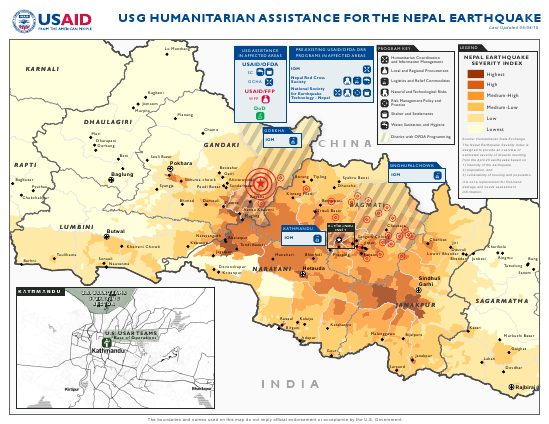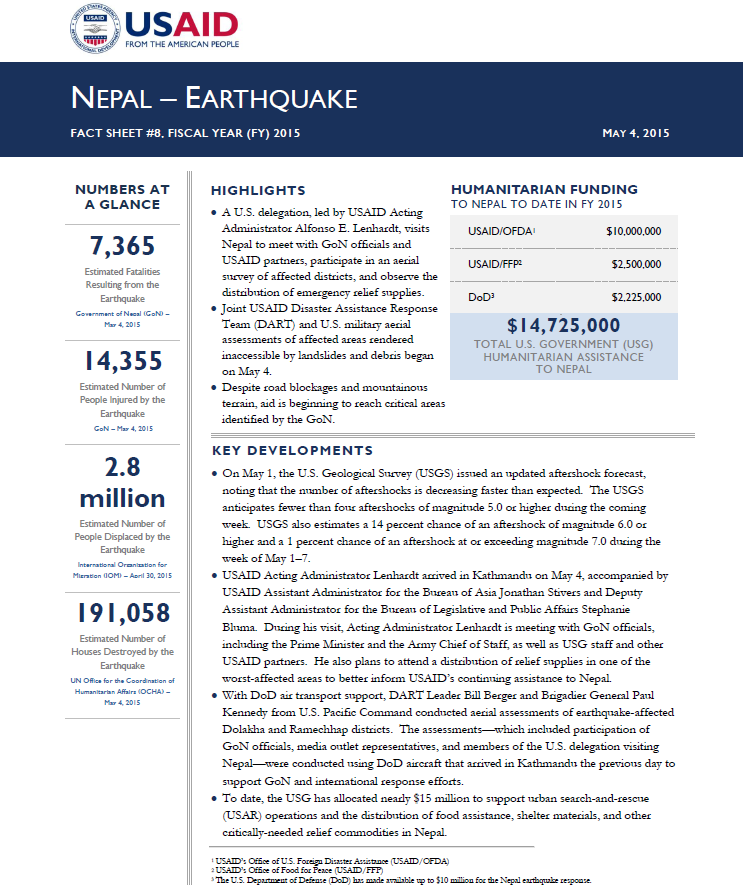Speeches Shim
May 4, 2015
Highlights
A U.S. delegation, led by USAID Acting Administrator Alfonso E. Lenhardt, visits Nepal to meet with GoN officials and USAID partners, participate in an aerial survey of affected districts, and observe the distribution of emergency relief supplies.
Joint USAID Disaster Assistance Response Team (DART) and U.S. military aerial assessments of affected areas rendered inaccessible by landslides and debris began on May 4.
Despite road blockages and mountainous terrain, aid is beginning to reach critical areas identified by the GoN.
Key Developments
Nepal Earthquake Map - May 4, 2015 ![]() (pdf - 1 MB)
(pdf - 1 MB)
Numbers At A Glance
7,365
14,355
2.8 million
191,058
Humanitarian Funding:
To Nepal To Date In FY2015:
| USAID/OFDA | $10,000,000 |
| USAID/FFP | $2,500,000 |
| DoD | $2,225,000 |
| TOTAL | $14,725,000 |
Nepal Earthquake Fact Sheet #8 - 05-04-2015 ![]() (pdf - 189k)
(pdf - 189k)
On May 1, the U.S. Geological Survey (USGS) issued an updated aftershock forecast, noting that the number of aftershocks is decreasing faster than expected. The USGS anticipates fewer than four aftershocks of magnitude 5.0 or higher during the coming week. USGS also estimates a 14 percent chance of an aftershock of magnitude 6.0 or higher and a 1 percent chance of an aftershock at or exceeding magnitude 7.0 during the week of May 1–7.
USAID Acting Administrator Lenhardt arrived in Kathmandu on May 4, accompanied by USAID Assistant Administrator for the Bureau of Asia Jonathan Stivers and Deputy Assistant Administrator for the Bureau of Legislative and Public Affairs Stephanie Bluma. During his visit, Acting Administrator Lenhardt is meeting with GoN officials, including the Prime Minister and the Army Chief of Staff, as well as USG staff and other USAID partners. He also plans to attend a distribution of relief supplies in one of the worst-affected areas to better inform USAID’s continuing assistance to Nepal.
With DoD air transport support, DART Leader Bill Berger and Brigadier General Paul Kennedy from U.S. Pacific Command conducted aerial assessments of earthquake-affected Dolakha and Ramechhap districts. The assessments—which included participation of GoN officials, media outlet representatives, and members of the U.S. delegation visiting Nepal—were conducted using DoD aircraft that arrived in Kathmandu the previous day to support GoN and international response efforts.
To date, the USG has allocated nearly $15 million to support urban search-and-rescue (USAR) operations and the distribution of food assistance, shelter materials, and other critically-needed relief commodities in Nepal.
USAR AND LOGISTICS
On May 3—more than one week after the magnitude 7.8 earthquake—the GoN issued formal letters of appreciation to international USAR teams, officially closing the international USAR phase of the response and requesting that teams arrange their exit plans. In response to the GoN’s request, the DART is preparing the demobilization of its Fairfax County, Virginia, and Los Angeles County, California, USAR teams. More than 50 USAR teams from 23 countries have supported the GoN’s rescue efforts across seven of the worst-affected districts, OCHA reports. These operations resulted in 16 successful live rescues and the recovery of 179 bodies from collapsed structures.
As rescue operations come to an end, the GoN is shifting its focus to the efficient delivery of relief assistance to severely affected communities throughout Nepal. Priority relief items, according to the GoN, include shelter materials, medical supplies, and food commodities, as well as agricultural inputs and feed and vaccines for livestock.
On May 4, the Logistics Cluster—the coordinating body for humanitarian logistical activities, comprising UN agencies, non-governmental organizations (NGOs) , and other stakeholders—requested assistance from DART civil-military advisors to deliver emergency shelter kits procured by Plan International. In coordination with the DART and the Nepalese Army, a U.S. military aircraft transported several shelter kits, containing ropes and tarpaulins, to earthquake-affected populations in Dolakha District. In coordination with the GoN, DART civil-military advisors and colleagues from the DoD Joint Humanitarian Assessment Survey Team (JHAST) continue to assess additional ways to address logistical support needs in Nepal.
DISPLACEMENT
As of May 2, IOM had recorded approximately 37,500 people residing in formal and informal displacement sites in Kathmandu Valley’s three districts through its displacement tracking matrix. Site populations continue to decline in Kathmandu District; however, in Bhaktapur District, which sustained greater damage, site populations remain steady.
Led by IOM, the Camp Coordination and Camp Management (CCCM) Cluster is developing response priorities to address the needs of people displaced by the earthquake. To prevent secondary displacement in rural communities, the cluster is advocating that partners assist displaced populations—many of whom remain displaced within their own villages—in their current location, rather than in camp settings. Although several displacement sites in Kathmandu Valley were locations pre-designated by the GoN, occupancy of these urban sites occurred in a spontaneous manner, leading to sub-standard conditions and heightened humanitarian needs. The CCCM Cluster aims to improve conditions in the sites that will remain open, as they will likely house poor and vulnerable populations whose rented or owned accommodations were destroyed or heavily damaged by the earthquake. Both the CCCM and Shelter clusters continue to advocate against the formation of camps as an emergency solution, stressing that camps are an option of last resort.

SHELTER
According to GoN estimates, the April 25 earthquake had destroyed more than 191,000 houses and damaged an additional 175,000 residences as of May 4. To assist recovery efforts throughout Nepal, the GoN has issued a $2 billion appeal for Nepal’s Reconstruction and Rehabilitation Fund.
Nepal’s schools are tentatively scheduled to reopen on May 15, reports the International Federation of Red Cross and Red Crescent Societies (IFRC). As many schools continue to serve as shelters for earthquake-affected households, alternative shelter solutions and structural vulnerability assessments of damaged houses are urgently needed.
Shelter Cluster leads IFRC and IOM have highlighted the need for humanitarian actors to re-focus their efforts beyond urban centers to rural and remote areas of Nepal’s Central and Western regions, where the earthquake caused the greatest damage. With the impending monsoon season—which typically begins in early June—the speed of response is of particular concern as monsoon rains are likely to render many remote areas inaccessible.
During the May 4 Shelter Cluster meeting, a representative of the European Commission’s Directorate-General for Humanitarian Aid and Civil Protection (ECHO) shared observations from his recent field visit to affected areas of Lamjung District. The observations echoed reports from USAID partners that many displaced people had set-up temporary shelters adjacent to their houses, preferring not to leave their local villages. Water sources in Lamjung appear unaffected by the earthquake, although communities are experiencing some sanitation issues. The REACH Initiative—a joint initiative between the Agency for Technical Cooperation and Development (ACTED), IMPACT Initiatives, and the UN Operational Satellite Applications Program (UNOSAT)—reported similar observations from assessed villages in Sindhupalchowk District, adding that while communities still had access to agricultural land, many had lost key agricultural inputs due to the earthquake.
On May 4, a USAID/OFDA Shelter and Settlements (S&S) Advisor arrived in Kathmandu to provide technical shelter expertise to the DART and wider humanitarian community. The S&S Advisor and other DART members met with USAID/OFDA partner the National Society for Earthquake Technology (NSET), which is working with the Nepal Engineer Association to train 1,000 engineers in conducting structural damage assessments using a methodology developed by NSET in 2011 with USAID/OFDA support.
HEALTH AND WASH
Although total figures for Nepal’s earthquake-affected population are still being determined, several thousands of people continue to live outdoors in challenging conditions that include rain, cool temperatures, and multiple aftershocks. Internally displaced persons (IDPs) throughout the affected areas have varying access to basic services, such as shelter and water, sanitation, and hygiene (WASH). For example, a USAID/Nepal WASH specialist recently visited IDP sites in Kathmandu Valley and observed that camp occupants were no longer using existing latrines as the facilities had become full and required maintenance. UN World Health Organization (WHO) assessment teams also visited some displacement sites and reported mild levels of diarrheal outbreak. Poor health and WASH conditions are also likely in remote, hard-to-reach districts outside of Kathmandu Valley due to the extent of earthquake-related damage and displacement.
To mitigate health risks following the earthquake, disease surveillance personnel are participating in GoN–WHO assessments of affected health facilities, and relief organizations have established disease surveillance for acute diarrhea in IDP sites and affected districts, according to the UN. The GoN is also conducting public health messaging to reduce the risk of disease outbreak. Relief organizations are also providing assistance to mitigate the spread of waterborne diseases, including basic shelter support, hygiene kits, water treatment supplies, and safe drinking water to improve conditions for IDPs.
FOOD SECURITY AND NUTRITION
The Food Security and Nutrition clusters have expressed concerns regarding the appropriateness of food and nutritional assistance distributed by some organizations, as well as the lack of coordination among some partners on food distributions. On April 30, the GoN Ministry of Health and Population issued a joint statement with the UN Children’s Fund (UNICEF) and the Nutrition Cluster regarding the unsolicited distribution of infant formula and other breast milk substitutions (BMSs). The statement urges all relief actors to refrain from distributing potentially hazardous BMSs, including infant food, formula, and juices, as well as feeding products such as baby bottles and teats.
In an effort to combat longer-term food insecurity, the UN Food and Agriculture Organization (FAO) and Oxfam are evaluating ways to meet agricultural needs that have resulted from the earthquake, which killed livestock and destroyed seed stocks and other agricultural products. Farmers need to plant rice seeds before the end of May to prepare for the upcoming growing season; many farmers, however, lack sufficient supplies. In response, FAO is exploring options for procuring rice seeds in India and Nepal for distribution to Nepalese farmers. In addition, although Nepal’s maize-growing season is currently underway, farmers risk losing part of their maize harvest as many people are unable to tend their crops.
On May 1–3, UN World Food Program (WFP) Executive Director Etharin Cousin visited Nepal to examine the earthquake’s impact on remote communities and hold high-level meetings with GoN officials, UN Under-Secretary-General and Emergency Relief Coordinator Valerie Amos, and EU Commissioner for Humanitarian Aid and Crisis Management Christos Stylianides.
CONTEXT
On April 25, a magnitude 7.8 earthquake struck central Nepal at a shallow depth of approximately 15 kilometers (km), according to the USGS. The epicenter of the earthquake was located approximately 77 km northwest of Kathmandu, the country’s capital city, and 73 km east of Pokhara, another major city in central Nepal.
The USG immediately issued a disaster declaration for Nepal due to the effects of the earthquake. Within hours of the seismic event, USAID/OFDA had activated a RMT in Washington, D.C., and deployed a DART—including USAR specialists—to support emergency response efforts in Nepal.
For nearly two decades, USAID/OFDA has supported disaster risk reduction (DRR) efforts in Nepal, including throughout Kathmandu Valley. USAID/OFDA funding has enabled the International Organization for Migration (IOM) to identify, prepare, and preserve more than 80 open spaces in Kathmandu Valley to ensure the sites are available for humanitarian purposes—such as distribution centers or warehouses—in the event of large-scale disasters. USAID/OFDA has also supported NRCS to pre-position critical emergency relief supplies in order to address the immediate needs of affected communities following a disaster.
Through the Kathmandu-based National Society for Earthquake Technology (NSET), USAID/OFDA is strengthening Nepal’s earthquake response capacity by institutionalizing DRR at the local and national levels in collaboration with the GoN, non-governmental organizations, schools, and local communities. With USAID/OFDA support, NSET is also promoting public-private partnerships for earthquake risk management and enhancing the capacity of municipal governments to develop and administer building code permits and control systems to better protect against seismic activity.
PUBLIC DONATION INFORMATION
The most effective way people can assist relief efforts is by making cash contributions to humanitarian organizations that are conducting relief operations. A list of humanitarian organizations that are accepting cash donations for disaster responses around the world can be found at www.interaction.org.
USAID encourages cash donations because they allow aid professionals to procure the exact items needed (often in the affected region); reduce the burden on scarce resources (such as transportation routes, staff time, and warehouse space); can be transferred very quickly and without transportation costs; support the economy of the disaster-stricken region; and ensure culturally, dietary, and environmentally appropriate assistance.
More information can be found at:
- The Center for International Disaster Information: www.cidi.org or +1.202.821.1999.
-
Information on relief activities of the humanitarian community can be found at www.reliefweb.int.




Comment
Make a general inquiry or suggest an improvement.